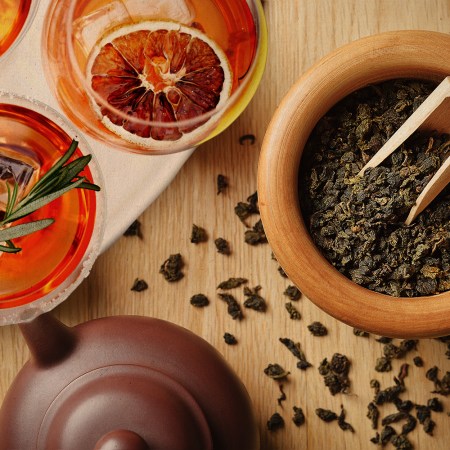The Old Fashioned calls for three dashes of Angostura bitters, and the Manhattan demands two. A truly quintessential Martini sings with a dash of orange bitters, and a Sazerac isn’t a Sazerac without four dashes of Peychaud’s. It’s easy to question the impact of an ingredient that gets added in such small doses, but bitters are undoubtedly the unsung heroes of mixology.
“The phrase we often hear and say is, ‘Bitters are the seasoning of a cocktail,’” says Marshall Minaya, beverage director at Valerie in New York. “Just like salt and pepper bring balance and depth to food, bitters enhance and amplify the flavors in a drink. They can highlight an existing ingredient or introduce a complementary note that ties the cocktail together.”
Florian Thireau, bar manager and director of mixology at Bar Crenn in San Francisco, breaks this down further. “For flavor, they add concentrated botanical flavors that can be spicy, herbal, floral, fruity or bitter, often in such small quantities that they enhance rather than dominate,” he says. “They contribute significant aromatic compounds that enhance the drinking experience through smell, often being the first impression of a cocktail. For balance, they help bridge gaps between sweet, sour and strong components in a cocktail, creating harmony between sometimes disparate flavors. For structure, they create edge and can lift up a drink with far more complexity and character, turning something simple into something sophisticated.”
The options when it comes to types of bitters have exploded in recent years, growing from time-honored staples to unique and unexpected varieties. Because of the virtually endless flavor possibilities — and because of everything there is to learn about what they are, how they function and why they’re important — bitters are also a rewarding and intriguing DIY project for home bartenders.
“Home bar enthusiasts are creative people,” says Bob Petrie, founder of Bob’s Bitters. “Making their own bitters would be another step in developing new skills. There may be a particular flavor they haven’t been able to find, and this would be an ideal opportunity to explore that.”
Neal Bodenheimer, owner of Cure and Cane & Table in New Orleans, notes that making your own bitters is a time-consuming project that’s not without its challenges. But learning to craft your own is worthwhile if you’re looking for more in-depth knowledge and are interested in hands-on endeavors. Bodenheimer likens it to homebrewing, despite the infinite beer options widely available. “You do it because you want to, because you want to learn,” he says. “There’s something nice about that knowledge of the botanicals, the herbs, the spices.”
Bitters 101
Bitters are made by extracting the flavors of fruits, roots, flowers, herbs, bark, spices and more into liquid. Typically, this liquid is a neutral base spirit, though Bodenheimer points out you can also make them with glycerin for a non-alcoholic iteration. Because many of those ingredients have long histories of being used medicinally in different cultures, bitters in some form have existed for centuries. The first major well-known brand that’s still widely used today is Angostura. In 1824, German doctor Johann Gottlieb Benjamin Siegert was living in a Venezuelan city (then called Angostura) and working as surgeon general for the military when he developed his recipe to aid digestion for soldiers.
Not long after in 1838, another still-iconic bitters debuted when New Orleans apothecary Antoine Amédée Peychaud invented his own eponymous blend, also initially for health-related purposes. At the time, the concept of the cocktail was just becoming more common and referred to any combination of a spirit with water, sugar and bitters. Cocktails proliferated during Prohibition when other flavors were needed to mask all of that barely-drinkable homemade hooch, and the market for ingredients like bitters grew.
Angostura has a flavor profile like baking spices, and Peychaud’s is anise-forward and fruity. Orange bitters joined the category, as well as other fixtures like celery bitters, Jerry Thomas bitters and Creole bitters. But the cocktail revolution of the last two decades has blown the doors on bitter possibilities wide open. Mole bitters are now ubiquitous, and craft brands offer everything from grapefruit, lemon, cherry and yuzu to tobacco, Earl Grey, vanilla, cardamom, bay leaf, patchouli, cucumber and umami.
The Homemade Bar: Go Deep on Bitterness and Botanicals With Amaro
There are endless possibilities when making this bittersweet liqueurGetting Started: Research, Planning and Ingredient Deep Dives
“Patience is the key in making your own bitters,” says Kareen Teague, bar manager at Dashfire in Minneapolis. This is not a project to be rushed into, as it requires research.
Minaya says the very first thing to do is “get a copy of Bitters by Brad Thomas Parsons. The book goes into the history of bitters and flavors and also includes recipes to make your own bitters.”
Minaya says two to four weeks is a reasonable timeline to expect when making bitters, but that’s after reading and experimenting. Research, personal preferences and interests, and cocktails provide inspiration for what ingredients one might want to work with to create certain flavors. Minaya recommends a few combinations he enjoyed making: pineapple anise, lemon verbena, root beer and coffee pecan. Initially, though, it might be most approachable to start with the basics.
“For the first attempt, I recommend using familiar ingredients then slowly adding to the recipe or exchanging ingredients for other flavors as confidence builds,” Petrie says. “The key is to keep tasting throughout the process and keep detailed notes.”
“Citrus peels are an easy way to start bitters, as the pith from citrus is naturally bitter but the oils from peels can yield bright aromas as well,” Teague says. “Dried roots and barks are interesting to work with, but use with caution. Not every root and bark can yield proper flavors and aromas, and some contain toxins. The same goes for herbs and flowers. Always research your ingredients before attempting to use them to make bitters.”
Research will also help build a flavor profile. You can start with something familiar and relatively easy like orange or grapefruit peel and complement it with spices and botanicals, especially as you work on subsequent batches.
“When I was working on a grapefruit bitter, I researched all ingredients that shared common aromatic compounds with grapefruit — such as Timur peppercorn, rhubarb, ginger and bergamot — so I could elevate the profile and make the grapefruit flavor more complex and nuanced,” Thireau says. He also experimented batch-to-batch with different forms of the grapefruit, from essential oils to peels. Essentially, pick a starting point you have a firm grasp on, and use research and inspiration from different cocktails and cuisines to build from there.
Each ingredient you work with will behave differently in your base spirit. The base spirit itself might change depending on those ingredients’ reactions, so trial-run macerations before launching into the blend for your bitters are key. Less neutral spirits like whiskey can be used to build more complex finishes, but in the beginning, it’s best to start with a blank slate like vodka to understand proof’s influence.
“Think about proof the way you think about temperature,” Bodenheimer says. “If you’re using things that are hard and hearty, you can use grain alcohol or overproof vodka. But delicate things like leafy greens need lower-proof spirits.”
Gather all the ingredients you’re thinking of working with, and know you may end up changing or downsizing after experimenting. Make sure to source high-quality versions and start with small amounts. Bodenheimer then advises thinking about any preparations you might make for these elements, like if you’re going to toast star anise before soaking to get some of its oils out. Also ensure that your bitters actually have a bitter component; Minaya recommends gentian root.
Let each ingredient sit in its own jar filled with alcohol; again, more delicate ingredients will work better in lower-proof spirits, whereas roots and bark may need the stronger stuff, but this will be determined through patience and tasting. Teague says some ingredients may extract their flavors in just a day, while others will take weeks, so taste your macerations regularly and track your findings.

Mixing It Up
Once you’ve landed on the best processes for each ingredient — your orange peel takes this long to extract in this proof spirit, your peppercorns this long in that — it’s time to blend everything together. This step might take you back to the drawing board if you blend and realize something’s missing or there’s too much going on. But when that blend is where you want it, you’re in the home stretch. Filter each of your jars into one clean jar using cheesecloth, and remember this likely won’t be equal amounts. Your bittering agent — gentian, wormwood, quassia bark, etc. — could be overpowering if added in the same amount as more delicate botanicals.
Take all the leftover solids and heat them with water on the stove, then transfer that mixture to its own jar. Let both the liquid and solid jars sit for about a week, then strain the latter’s liquid into the former. Keep straining until you have something nice and clear, and then, depending on your own tastes, you may want to add some sweetener. This will be something like simple syrup, demerara syrup, honey or maple syrup; from light and sweet to warm and rich, it should complement the rest of your flavors.
Enjoying the Results
Once you’ve your finished bitters, there are myriad ways to use them. If you’ve created something a bit more traditional, it’s probably safe to start dashing them into Old Fashioneds and Martinis. If you’ve been a bit more creative, start by adding them to sparkling water just to enjoy their flavors solo before incorporating them into recipes.
You can even cook with bitters, Petrie notes. He adds Bob’s Coriander Bitters and Bob’s Ginger Bitters to Asian dressing, Bob’s Spring Bitters to a gluten-free elderflower and lemon cake, and the coriander and cardamom bitters to batata harra.
“There are very few cocktails that aren’t improved by even a small amount of bitters,” Bodenheimer says, naming only the Daiquiri as one to leave as is. The more you experiment with your own bitters, the more you’ll understand about flavor profiles and what works with what and why, and you’ll definitely have something to brag about when mixing up a drink for guests at your next gathering.
Join America's Fastest Growing Spirits Newsletter THE SPILL. Unlock all the reviews, recipes and revelry — and get 15% off award-winning La Tierra de Acre Mezcal.

























